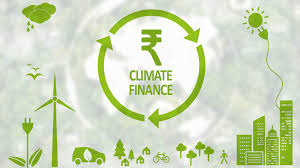GS3 – Environment

Context
According to Deloitte’s report ‘The Climate Response’, India needs approximately $1.5 trillion by 2030 to meet its climate and energy goals. Key investment needs include:
- $250 billion for non-fossil fuel capacity
- $300 billion for expanding energy storage infrastructure
What is Climate Finance?
Defined by the UNFCCC, climate finance includes public and private funding aimed at supporting climate mitigation and adaptation efforts.
Under Article 9 of the Paris Agreement, developed nations are committed to mobilising $100 billion annually for developing countries through 2025, based on CBDR-RC (Common but Differentiated Responsibilities and Respective Capabilities).
Modes of Climate Finance
- Green Bonds:
Debt instruments to fund eco-friendly infrastructure or projects. - Climate Funds:
Multilateral or public sources of finance for adaptation and mitigation efforts. - Blended Finance:
Combines public and private capital to spread risks and attract private investment. - Carbon Credits:
Certificates allowing holders to offset emissions by purchasing reductions elsewhere. - Debt-for-Climate Swaps:
Convert external debt into domestic investments for climate-related goals. - Concessional Loans:
Loans offered at below-market rates to facilitate climate-friendly investments. - Grants:
Non-repayable funding for projects, especially in vulnerable regions. - Guarantees:
Mechanisms to protect investors against risks of project failure.
Global Climate Finance Trends
- Scale:
Surpassed $2 trillion globally in 2024, indicating strong momentum. - Skewed Allocation:
~90% of global funding supports mitigation, while only ~$65 billion (3.4%) went toward adaptation in 2023. - Private Sector Involvement:
Accounts for ~49% of total flows, largely in mitigation due to expected returns. - Geographic Distribution:
Emerging markets received ~59%, mainly through public international sources. - Financing Instruments:
Approximately 69% of the flows were delivered via debt or equity instruments.
Challenges in Global Climate Finance
- Ambiguity in Definitions:
Lack of standardised definitions reduces transparency and cross-national comparability. - Misleading Reporting:
Developed countries often inflate financial contributions using inconsistent accounting standards. - Adaptation Neglect:
Only 5% of funds support adaptation, despite its importance for vulnerable nations. - Overreliance on Debt:
With 69% of finance being debt-based, recipient countries risk increasing fiscal stress. - Weak Compliance Mechanisms:
No enforceable measures exist for non-compliance with climate finance commitments.
Challenges for India in Climate Finance
- Private Sector Hesitancy:
Limited private investment in adaptation projects due to low returns. - Project Risk:
Long payback periods and infrastructure complexities discourage lending. - Debt Constraints:
India’s increasing debt burden makes access to concessional finance difficult. - Policy Misalignment:
Domestic financial regulations often do not align with global climate fund eligibility criteria. - Urban Bias:
A disproportionate amount of climate finance is directed to urban areas, sidelining rural and high-risk regions.
India’s Climate Finance Initiatives
- NCEF (National Clean Energy Fund):
Utilises coal cess revenue to promote clean energy technologies and research. - NAFCC (National Adaptation Fund for Climate Change):
Supports climate resilience initiatives in vulnerable states. - Sovereign Green Bonds:
Launched in Budget 2022–23 to fund public green infrastructure. - RBI’s Sustainable Finance Group (SFG):
Establishes green finance norms and disclosure requirements. - Priority Sector Lending:
The RBI includes renewable energy under PSL to enhance credit availability. - NABARD’s 2030 Strategy:
Aims to scale rural green financing and boost climate adaptation. - Access to GCF:
India has tapped the Green Climate Fund to support adaptation and clean energy projects.
Way Forward
- Concessional Financing Model:
India could replicate UAE’s $30 billion concessional fund to draw private capital. - Debt-for-Climate Swaps:
Implement models like Belize to restructure debt into climate-related investments. - Unified National Fund:
Establish a centralised climate finance mechanism like Brazil’s Amazon Fund. - Just Energy Transition Partnership (JETP):
Engage in transition finance agreements to support coal phase-out and renewable integration. - Predictable Funding:
Adopt multi-year funding commitments (e.g., Germany’s model) to improve investor confidence. - Green Budget Tagging:
Implement Chile-style fiscal tagging to ensure transparency in public green expenditure.




